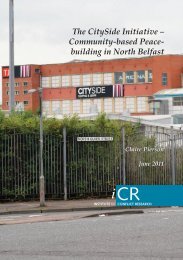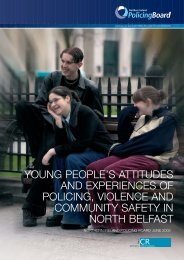Young People and Interfaces Report - Institute for Conflict Research
Young People and Interfaces Report - Institute for Conflict Research
Young People and Interfaces Report - Institute for Conflict Research
Create successful ePaper yourself
Turn your PDF publications into a flip-book with our unique Google optimized e-Paper software.
YOUNG PEOPLE AND INTERFACES<br />
4. Discussion <strong>and</strong> Key Findings<br />
If as Margaret O’Brien argues, one of the main principles of a ‘just city’ is that it enables the<br />
free movement of children through it (O’Brien et al. 2000: 258), then it is debatable whether<br />
or not Belfast as of May 2012 would qualify. While clearly some young people living at the<br />
interface feel relatively free to go where they please, there remain issues associated with a<br />
restricted sense of movement in <strong>and</strong> around the interface <strong>for</strong> many others, particularly with<br />
regards to accessing particular services <strong>and</strong> facilities.<br />
Despite the fact that many young people did not uncritically or passively accept narratives of ‘safe’<br />
<strong>and</strong> ‘unsafe’ space as told to them by their friends, family <strong>and</strong> others (Leonard 2010c), it remained<br />
the case that <strong>for</strong> many there was a wariness associated with the ‘Other’ community <strong>and</strong> in moving<br />
through the territory of the ‘Other’. This was particularly the case in the evenings <strong>and</strong> during the<br />
summer months when various trigger events can increase tensions between communities.<br />
For teenagers who feel they are too old to get involved in st<strong>and</strong>ard youth club activities <strong>and</strong> <strong>for</strong><br />
whom there seems little else to do, w<strong>and</strong>ering the streets where they live becomes a regular<br />
occurrence <strong>and</strong> in <strong>and</strong> of itself is not necessarily a bad thing. Indeed, this ‘neighbourhood<br />
nationalism’ (Webster 2003) <strong>and</strong> attachment to an area where friends <strong>and</strong> family live is an<br />
important part of developing a sense of place bound identity (Matthews et al. 2000; Laughlin <strong>and</strong><br />
Johnson 2011). However, the difficulty in Northern Irel<strong>and</strong> occurs where locality, territory <strong>and</strong><br />
ethnicity intersect, particularly when groups of young people encounter one another at the interface<br />
(Healy 2006).<br />
The visible presence of groups of young people on the street is also often perceived by adults as<br />
young people being ‘up to no good’ which in turn alienates young people further from local adults<br />
<strong>and</strong> wider society (Rad<strong>for</strong>d et al. 2005). The constant moving on of young people from public<br />
spaces, which while underst<strong>and</strong>able in some ways as a response to resident fears of large<br />
numbers of young people in public, does little to alter perceptions that they are regarded as little<br />
more than a ‘nuisance’, <strong>and</strong> this can also feed into negative perceptions of the police who are<br />
responding to residents’ concerns.<br />
Of course there are young people who gather at interfaces with the intention of, or indeed actually,<br />
getting involved in violence. This is clearly a key issue which needs to be tackled by the police <strong>and</strong><br />
other organisations to, if possible, prevent a young person from coming in to contact with the<br />
criminal justice system. The 174 Trust have begun a ‘Together Stronger’ project which will run until<br />
2015 <strong>and</strong> which aims to improve community relations at the Carlisle Circus interface. One aspect<br />
of this project will be to engage with marginalised young people in the surrounding areas who may<br />
be at risk of engaging in interface violence <strong>and</strong> coming into contact with the criminal justice system<br />
– this project <strong>and</strong> others like it should be welcomed as a step in the right direction in terms of<br />
improving engagement with young people at the interface.<br />
Despite the potential of this <strong>and</strong> other similar one-off projects, all young people in public spaces<br />
should not be judged as being ‘up to no good’ purely on account of their age <strong>and</strong> their appearance<br />
in public space. The position of many young people in interface areas <strong>and</strong> beyond is often on the<br />
periphery of citizenship, without a full sense of place in the community, where they are viewed as in<br />
the process of ‘becoming’ adults, but they are not yet complete social beings (Blitzer 1991;<br />
Leonard 2006b: 1129). This may mean that in times of interface violence, getting involved to<br />
30






